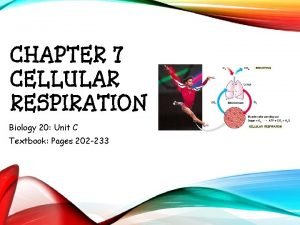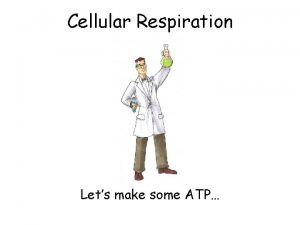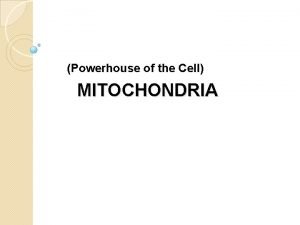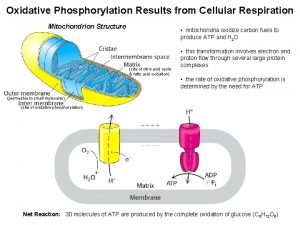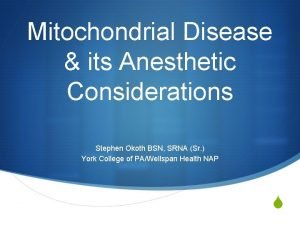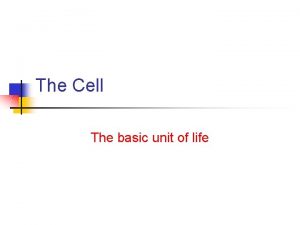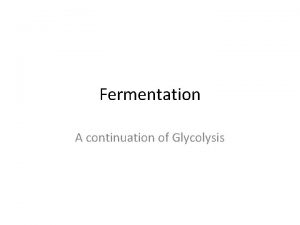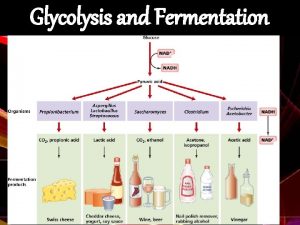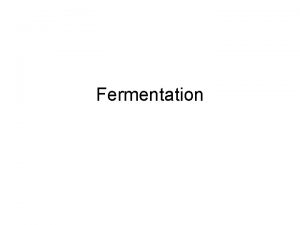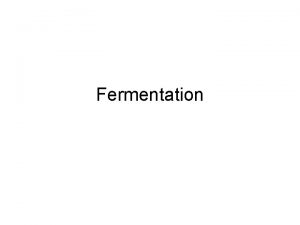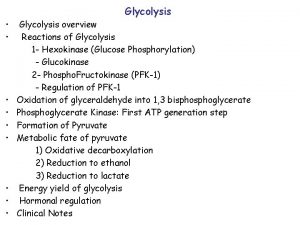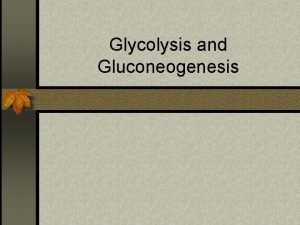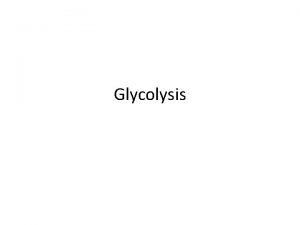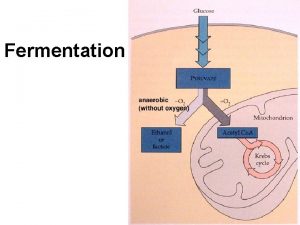Fermentation Step 1 Glycolysis Mitochondrion Glucose C C










- Slides: 10

Fermentation

Step 1: Glycolysis Mitochondrion Glucose C C C Enzyme PC ATTP A C C C 6 H 12 O 6 • Where? In cytoplasm • What happens? A) Glucose (from our food) is broken down into 2 pyruvate (2 - 3 carbon molecules) B) 2 ATP molecules released for cellular processes

What’s after Glycolysis? glycolysis O 2 2 No fer me nt ati on ATP O • Glycolysis – Creates: 2 ATP & 2 Pyruvate (2 - 3 carbon molecules) – Leads to either: 1) Aerobic Respiration • With oxygen present • Kreb’s Cycle • Electron transport chain 2) Anaerobic Respiration • Without oxygen • Fermentation • Allows glycolysis to restart ATP

Step 2: Fermentation Yeast perform alcoholic fermentation to make bread. Why isn’t bread alcoholic? Alcohol evaporates in the baking process During prolonged exercise, the oxygen you inhale mainly goes to your brain. Howmuscles to relieve Your aresore nowmuscles: lacking oxygen. 1) Massage 2) Bananas 3) Stretch after 4) Hydrate Muscle cells perform fermentation to keep you going! • Two Types of Fermentation (both anaerobic): A) Lactic Acid fermentation – Performed by animals when muscle cells are not receiving O 2 – Lactic acid waste created B) Alcoholic fermentation – Performed by yeast, some plants, bacteria – Alcohol and CO waste created

Lactic Acid vs. Alcoholic Fermentation glycolysis Lactic acid glycolysis Alcohol + CO 2 Lactic acid fermentation Lactic Acid • Location: Cytoplasm • Amount of ATP created: Zero • The Point? Make molecules to restart glycolysis • Waste: Lactic acid Alcoholic fermentation Alcoholic • Location: Cytoplasm • Amount of ATP created: Zero • The Point? Make molecules to restart glycolysis • Waste: Alcohol and CO 2

Aerobic Respiration nt e s Glycolysis Where? In the cytoplasm y x ho t Wi What happens? • Glucose is split into 2 Pyruvate (2 - 3 carbon molecules) If o • 2 ATP created x yg Glycolysis restarts re p n ge en Where? In the mitochondria Steps? Kreb’s cycle and electron transport chain What happens? 2 Pyruvate (2 - 3 carbon molecules) create up to 36 ATPs is l ac kin Fermentation g Where? In the cytoplasm What happens? • Pyruvate (2 - 3 carbon molecules) are broken into either lactic acid or alcohol • Molecules to restart glycolysis created (No ATP)

Public Service Announcement: Proper Use of Alcohol

The Maple Center Counseling • Safe Rides are available on Friday and Saturday nights from 10: 00 pm to 2: 00 am for teens living in Beverly Hills. High school students can call for a free ride home when they are under the influence of drugs and/or alcohol. When the teenager calls the Safe Ride number, the TMCC counselor assigned to the 24 -hour HELP-LINE arranges for that teen to be picked up by the Beverly Hills Cab Company and taken home. Services are confidential. • Call (888) 654 -3211 for a free ride home.

Review 1) 2) 3) 4) 5) 6) Name the two types of fermentation. How much ATP does glycolysis create? How much ATP does fermentation create? Which molecule is broken down during glycolysis? A buildup of which molecule causes sore muscles? Which waste molecules are created by alcoholic fermentation? 7) Which waste molecules are created by lactic acid fermentation? 8) Is fermentation aerobic or anaerobic? What does this mean? 9) Why is aerobic (cellular) respiration preferred vs. fermentation?

Review Answers Name the two types of fermentation. 1) Lactic Acid and Alcoholic How much ATP does glycolysis create? • 2 ATP How much ATP does fermentation create? • ZERO ATP Which molecule is broken down during glycolysis? • Glucose A buildup of which molecule causes sore muscles? • Lactic Acid Which waste molecules are created by alcoholic fermentation? • Alcohol and CO 2 Which waste molecules are created by lactic acid fermentation? • Lactic Acid Is fermentation aerobic or anaerobic? What does this mean? • Anaerobic, which means the process does NOT require oxygen Why is aerobic (cellular) respiration preferred vs. fermentation? • Aerobic (cellular) respiration creates more ATP; specifically up to 36 ATP, while fermentation does not create any ATP, but allows glycolysis to continue. • 2) 3) 4) 5) 6) 7) 8) 9)

